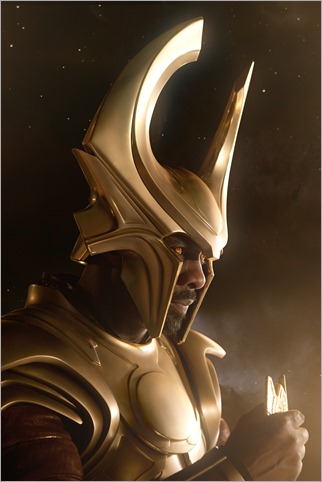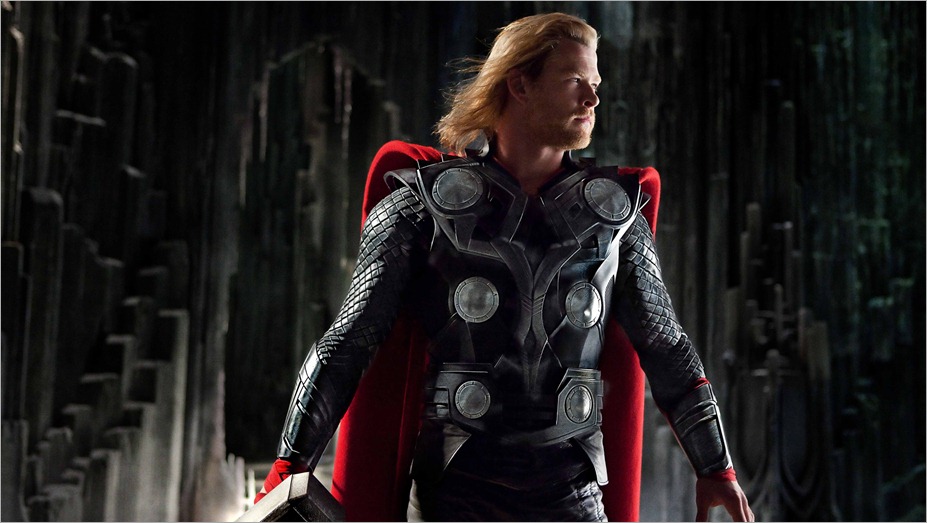This post is the unedited copy of Thor’s film review, published Sunday May 22, 2011 in our film review column Animadversion (iMAGES on Sunday, Dawn Newspaper). The link to the published version can be found at the end of the post.
* Correction appended on June 10th 2011. Previously published version cited Odin as “Old-Father”, and not “All-Father”. Blame the mistake on a bad ear-day.
Shakespeare, Shakespeare Oh, Where Art Thou?
By Mohammad Kamran Jawaid
Let’s talk about “Thor” from the villain’s angle: People always said that he has a predilection for mischief, but Loki (Tom Hiddleston, looking every bit like Iago from Shakespeare’s Othello) has conflict weighing on his immortal soul. To betray or not to betray, his expression asks in not as many words.
Raised as a prince, he will never be King. At least not until his younger brother is vanquished, or his father – “All-Father Odin” (Anthony Hopkins) – dies; for an immortal that’s nearly an impractical solution. Loki then happens upon an awful truth: He is not Odin’s son. Born as a frost giant – an evil war-mongering race that delivers the film’s initial action – he was taken by Odin as a bargaining chip.
Not of Odin’s blood stabs through Loki, who to be King through subterfuge gets rids of his foster kin (the soon-to-be-King) Thor – a perfectly hunkified Chris Hemsworth who initially plays an arrogant hero with brawns for brains and wields the impossible to lift hammer Mjolnir (also the source for his awesome powers over thunder).
In Kenneth Branagh’s adaptation of the mighty Thor, who in heaven or hell actually kills their father? After all Loki – and almost everyone in the immortal realm of Asgard – do call him “All-Father”.
As Odin, ruler of Asgard – a towering computer generated city in an uncharted celestial plane – Mr. Hopkins is not the “All-Father” infallible from Stan Lee’s imagination (as many of the Marvel lineup he is Mr. Lee’s creation too). I remember from issue No. 123 of “Journey into Mystery” (December 1965), when the incredible Absorbing Man – a mug with the power to turn his body into whatever material he pats – wrecks Asgard to rubble. For the comic’s 22 pages Odin lets the villain play, only to fling him across the universe by a flick of his finger at the last page.
By Mr. Branagh’s turn, Mr. Hopkins, sporting a metal eye-patch, grumbles and thunders on stagy cue to cash what I believe would be a really big pay check. Mr. Hopkin’s Odin is visibly old and dying. In one dramatic scene that acts as a catalyst for the second half, he grabs his heart – already clogged with Shakespearean-logic – falls on the stairs and slips into coma. He couldn’t be more fragile and mortal and Mr. Branangh couldn’t have been more astute.
Although William Shakespeare never had his woe-stuck heroes’ battle frost giants with shape-shifting fists, the Shakespearean logic plays well with Asgardian folklores; that is until Thor is tossed down to Earth for his arrogance. The Earth-bit, where he is banished as punishment like a petulant child, often dithers from funny (as when the god of thunder is tazered to unconsciousness) to drabness (the climax and the ineffectual second hour).
I wonder how Thor took $150 million to make. The town, where he is thrown near Mexico is as vacant as a low-budget one-street western town towering on support-boards. And certainly, the special effects, popping up whenever the camera looks at Asgard, could not have been worth $50 million. That’s just highway robbery – or perhaps the price a high-profile film pays these days.
Written by Ashley Edward Miller, Zack Stentz and Don Payne, the film also features a knock-out supporting cast with Natalie Portman (as the love-interest Jane Foster), Stellan Skarsgard (Dr. Selvig), Kat Dennings (Darcy), Clark Gregg (S.H.I.E.L.D Agent Coulson), Colm Feore (Laufey), Idris Elba (as the Asgardian gatekeeper Heimdall, with a part more substantial than Thor), Anthony Hopkins (Odin), Rene Russo (Frigga) and Jaimie Alexander (Sif).
Produced by Marvel Studios and Released by Paramount, Thor is rated PG-13. No nudity. No sex. This is kiddie pop-corn stuff with a Shakespearean sleight of hand. Well done Mr. Branagh.
Second Op
By Farheen Jawaid
 Hulking big, strikingly blond and brashly bold, Marvels comics (movies) Norse god Thor jumps into action with his hammer in hand, but he doesn’t hit all the targets. Like his Avenger brethren Iron Man’s franchise, “Thor” saves itself with sense of humor and a strong likable cast.
Hulking big, strikingly blond and brashly bold, Marvels comics (movies) Norse god Thor jumps into action with his hammer in hand, but he doesn’t hit all the targets. Like his Avenger brethren Iron Man’s franchise, “Thor” saves itself with sense of humor and a strong likable cast.
Chris Hemsworth, remembered for his Star Trek cameo as James Kirk father, in his first big lead role as “Thor” grins and swooshes his gold hair like a pro, and pulls off the god of thunder with the right balance of arrogance and confusion (especially when facing a life sentence on Earth). He also gets reliable support from Anthony Hopkins as Odin Thor’s Godly father, Tom Hiddleston as Loki the treacherous step-brother, notably pleasant Stellan Skarsgård as Dr. Erik Selvig, and Natalie Portman as the love interest/brainy scientist – who all get the job done for the sake of a good paycheck.
As director Kenneth Branagh, predominantly known as actor and then as director with mostly Shakespearian works to his credit, brings what he is used to: the Theatric-Shakespearean touch (case in point: the classic brother against brother bit and jealousy for the love of ones parents).
Human interaction is the strongest point of “Thor” and Mr. Branagh delivers it with panache. In spite of this small victory, Mr. Branagh is not known for being visual motivated, Thor’s CG action and the world of Asgard looks insipid and apathetic.
“Thor” has drama, action and plenty of one liners (particularly in the second half) to get the ball rolling but never is it a virtuoso; I guess no one said it would be.
